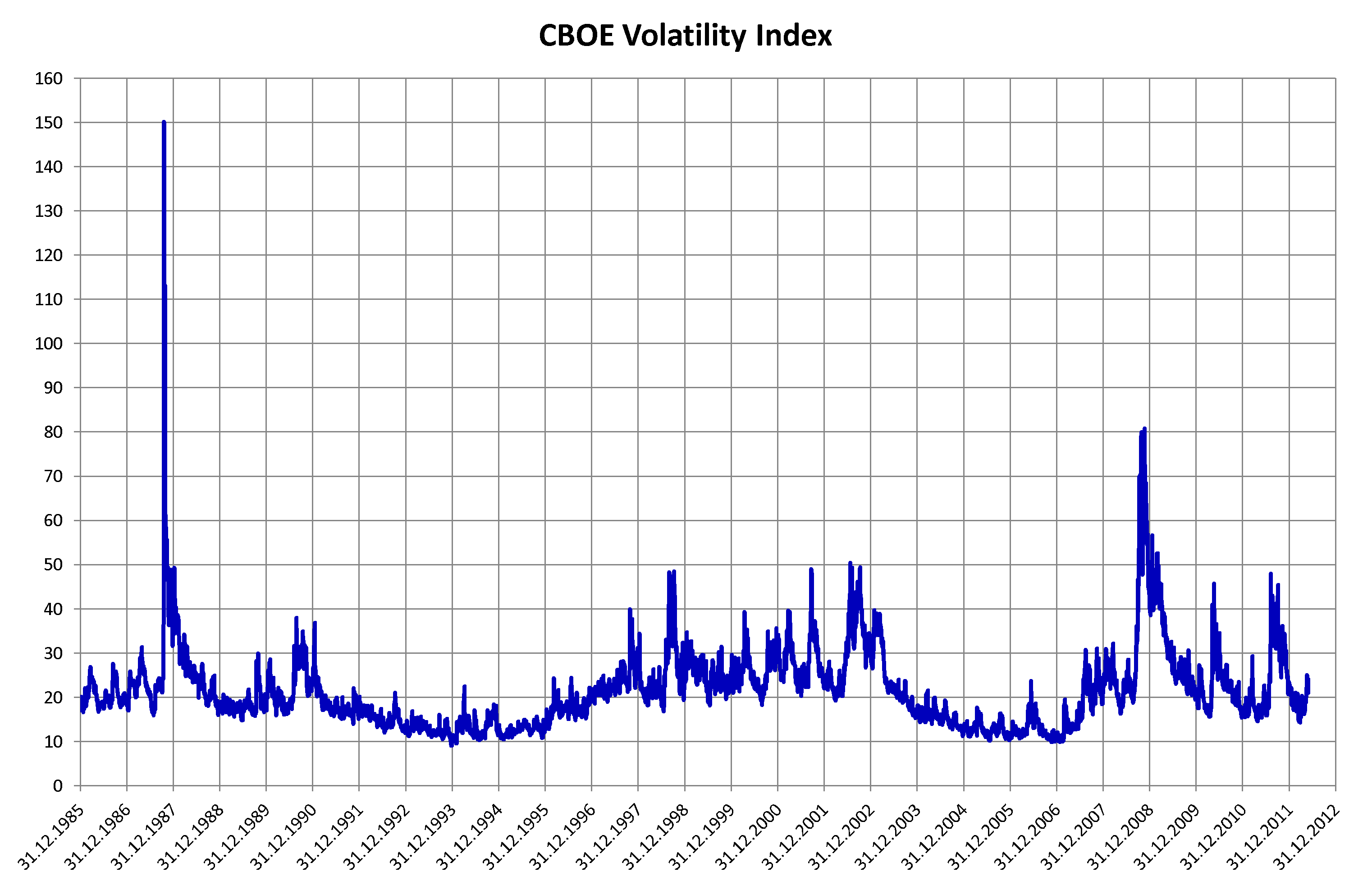|
Realized Variance
Realized variance or realised variance (RV, see spelling differences) is the sum of squared returns. For instance the RV can be the sum of squared daily returns for a particular month, which would yield a measure of price variation over this month. More commonly, the realized variance is computed as the sum of squared intraday returns for a particular day. The realized variance is useful because it provides a relatively accurate measure of volatility which is useful for many purposes, including volatility forecasting and forecast evaluation. Related quantities Unlike the variance the realized variance is a random quantity. The realized volatility is the square root of the realized variance, or the square root of the RV multiplied by a suitable constant to bring the measure of volatility to an annualized scale. For instance, if the RV is computed as the sum of squared daily returns for some month, then an annualized realized volatility is given by \sqrt. Properties under ideal co ... [...More Info...] [...Related Items...] OR: [Wikipedia] [Google] [Baidu] |
American And British English Spelling Differences
Despite the various list of dialects of English, English dialects spoken from country to country and within different regions of the same country, there are only slight regional variations in English orthography, the two most notable variations being British and American spelling. Many of Comparison of American and British English, the differences between American English, American and British English, British or English in the Commonwealth of Nations, Commonwealth English date back to a time before spelling standards were developed. For instance, some spellings seen as "American" today were once commonly used in Britain, and some spellings seen as "British" were once commonly used in the United States. A "British standard" began to emerge following the 1755 publication of Samuel Johnson's ''A Dictionary of the English Language'', and an "American standard" started following the work of Noah Webster and, in particular, his ''Webster's Dictionary, An American Dictionary of the ... [...More Info...] [...Related Items...] OR: [Wikipedia] [Google] [Baidu] |
Variance
In probability theory and statistics, variance is the expected value of the squared deviation from the mean of a random variable. The standard deviation (SD) is obtained as the square root of the variance. Variance is a measure of dispersion, meaning it is a measure of how far a set of numbers is spread out from their average value. It is the second central moment of a distribution, and the covariance of the random variable with itself, and it is often represented by \sigma^2, s^2, \operatorname(X), V(X), or \mathbb(X). An advantage of variance as a measure of dispersion is that it is more amenable to algebraic manipulation than other measures of dispersion such as the expected absolute deviation; for example, the variance of a sum of uncorrelated random variables is equal to the sum of their variances. A disadvantage of the variance for practical applications is that, unlike the standard deviation, its units differ from the random variable, which is why the standard devi ... [...More Info...] [...Related Items...] OR: [Wikipedia] [Google] [Baidu] |
Volatility (finance)
In finance, volatility (usually denoted by "sigma, σ") is the Variability (statistics), degree of variation of a trading price series over time, usually measured by the standard deviation of logarithmic returns. Historic volatility measures a time series of past market prices. Implied volatility looks forward in time, being derived from the market price of a market-traded derivative (in particular, an option). Volatility terminology Volatility as described here refers to the actual volatility, more specifically: * actual current volatility of a financial instrument for a specified period (for example 30 days or 90 days), based on historical prices over the specified period with the last observation the most recent price. * actual historical volatility which refers to the volatility of a financial instrument over a specified period but with the last observation on a date in the past **near synonymous is realized volatility, the square root of the realized variance, in turn c ... [...More Info...] [...Related Items...] OR: [Wikipedia] [Google] [Baidu] |
Quadratic Variation
In mathematics, quadratic variation is used in the analysis of stochastic processes such as Brownian motion and other martingales. Quadratic variation is just one kind of variation of a process. Definition Suppose that X_t is a real-valued stochastic process defined on a probability space (\Omega,\mathcal,\mathbb) and with time index t ranging over the non-negative real numbers. Its quadratic variation is the process, written as t, defined as : t=\lim_\sum_^n(X_-X_)^2 where P ranges over partitions of the interval ,t/math> and the norm of the partition P is the mesh. This limit, if it exists, is defined using convergence in probability. Note that a process may be of finite quadratic variation in the sense of the definition given here and its paths be nonetheless almost surely of infinite 1-variation for every t>0 in the classical sense of taking the supremum of the sum over all partitions; this is in particular the case for Brownian motion. More generally, the covariation ... [...More Info...] [...Related Items...] OR: [Wikipedia] [Google] [Baidu] |
Journal Of The Royal Statistical Society
The ''Journal of the Royal Statistical Society'' is a peer-reviewed scientific journal of statistics. It comprises three series and is published by Oxford University Press for the Royal Statistical Society. History The Statistical Society of London was founded in 1834, but would not begin producing a journal for four years. From 1834 to 1837, members of the society would read the results of their studies to the other members, and some details were recorded in the proceedings. The first study reported to the society in 1834 was a simple survey of the occupations of people in Manchester, England. Conducted by going door-to-door and inquiring, the study revealed that the most common profession was mill-hands, followed closely by weavers. When founded, the membership of the Statistical Society of London overlapped almost completely with the statistical section of the British Association for the Advancement of Science. In 1837 a volume of ''Transactions of the Statistical Society ... [...More Info...] [...Related Items...] OR: [Wikipedia] [Google] [Baidu] |
Stochastic Integral
Stochastic calculus is a branch of mathematics that operates on stochastic processes. It allows a consistent theory of integration to be defined for integrals of stochastic processes with respect to stochastic processes. This field was created and started by the Japanese mathematician Kiyosi Itô during World War II. The best-known stochastic process to which stochastic calculus is applied is the Wiener process (named in honor of Norbert Wiener), which is used for modeling Brownian motion as described by Louis Bachelier in 1900 and by Albert Einstein in 1905 and other physical diffusion processes in space of particles subject to random forces. Since the 1970s, the Wiener process has been widely applied in financial mathematics and economics to model the evolution in time of stock prices and bond interest rates. The main flavours of stochastic calculus are the Itô calculus and its variational relative the Malliavin calculus. For technical reasons the Itô integral is the mos ... [...More Info...] [...Related Items...] OR: [Wikipedia] [Google] [Baidu] |
Brownian Motion
Brownian motion is the random motion of particles suspended in a medium (a liquid or a gas). The traditional mathematical formulation of Brownian motion is that of the Wiener process, which is often called Brownian motion, even in mathematical sources. This motion pattern typically consists of Randomness, random fluctuations in a particle's position inside a fluid sub-domain, followed by a relocation to another sub-domain. Each relocation is followed by more fluctuations within the new closed volume. This pattern describes a fluid at thermal equilibrium, defined by a given temperature. Within such a fluid, there exists no preferential direction of flow (as in transport phenomena). More specifically, the fluid's overall Linear momentum, linear and Angular momentum, angular momenta remain null over time. The Kinetic energy, kinetic energies of the molecular Brownian motions, together with those of molecular rotations and vibrations, sum up to the caloric component of a fluid's in ... [...More Info...] [...Related Items...] OR: [Wikipedia] [Google] [Baidu] |
Converges In Distribution
In probability theory, there exist several different notions of convergence of sequences of random variables, including ''convergence in probability'', ''convergence in distribution'', and ''almost sure convergence''. The different notions of convergence capture different properties about the sequence, with some notions of convergence being stronger than others. For example, convergence in distribution tells us about the limit distribution of a sequence of random variables. This is a weaker notion than convergence in probability, which tells us about the value a random variable will take, rather than just the distribution. The concept is important in probability theory, and its applications to statistics and stochastic processes. The same concepts are known in more general mathematics as stochastic convergence and they formalize the idea that certain properties of a sequence of essentially random or unpredictable events can sometimes be expected to settle down into a behavior that i ... [...More Info...] [...Related Items...] OR: [Wikipedia] [Google] [Baidu] |
Realized Kernel
The realized kernel (RK) is an estimator of volatility. The estimator is typically computed with high frequency return data, such as second-by-second returns. Unlike the realized variance Realized variance or realised variance (RV, see spelling differences) is the sum of squared returns. For instance the RV can be the sum of squared daily returns for a particular month, which would yield a measure of price variation over this month. ..., the realized kernel is a robust estimator of volatility, in the sense that the realized kernel estimates the appropriate volatility quantity, even when the returns are contaminated with noise. Notes {{Reflist Mathematical finance ... [...More Info...] [...Related Items...] OR: [Wikipedia] [Google] [Baidu] |

